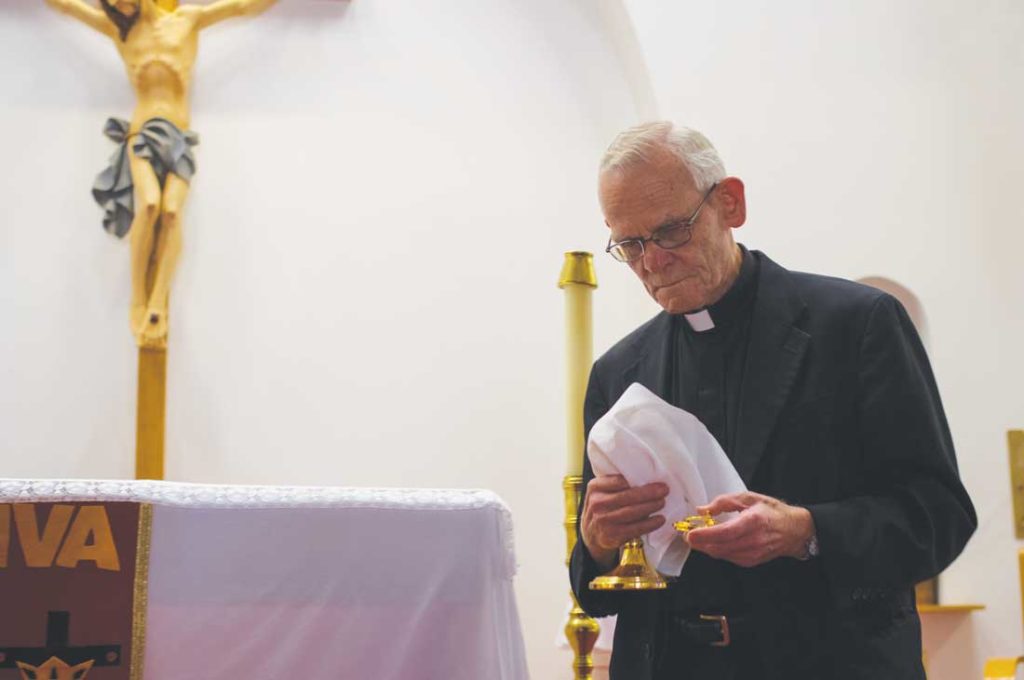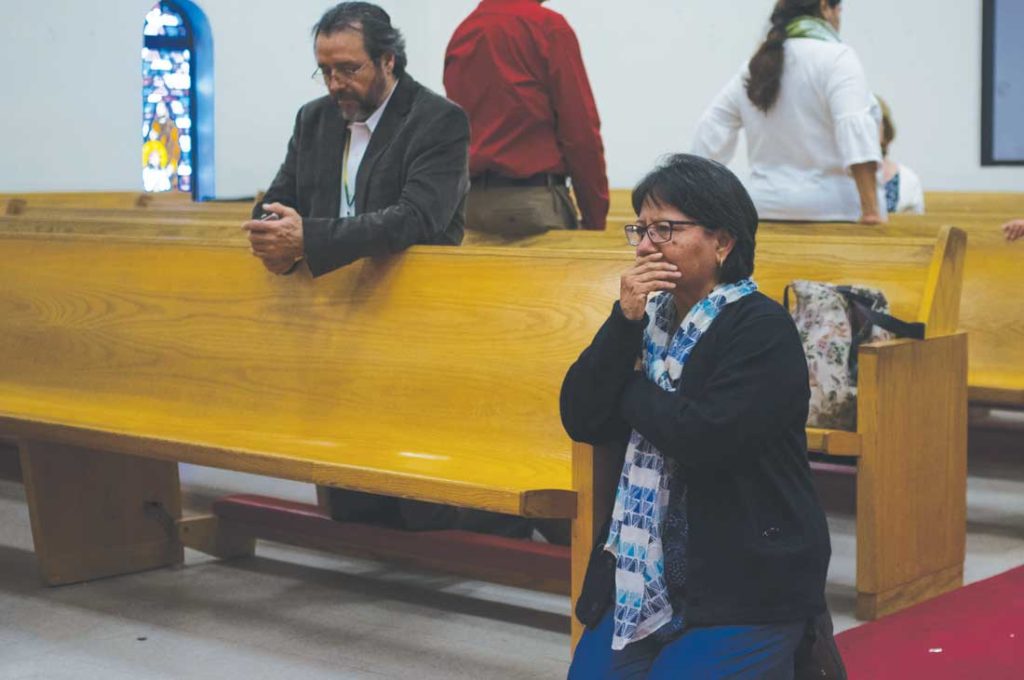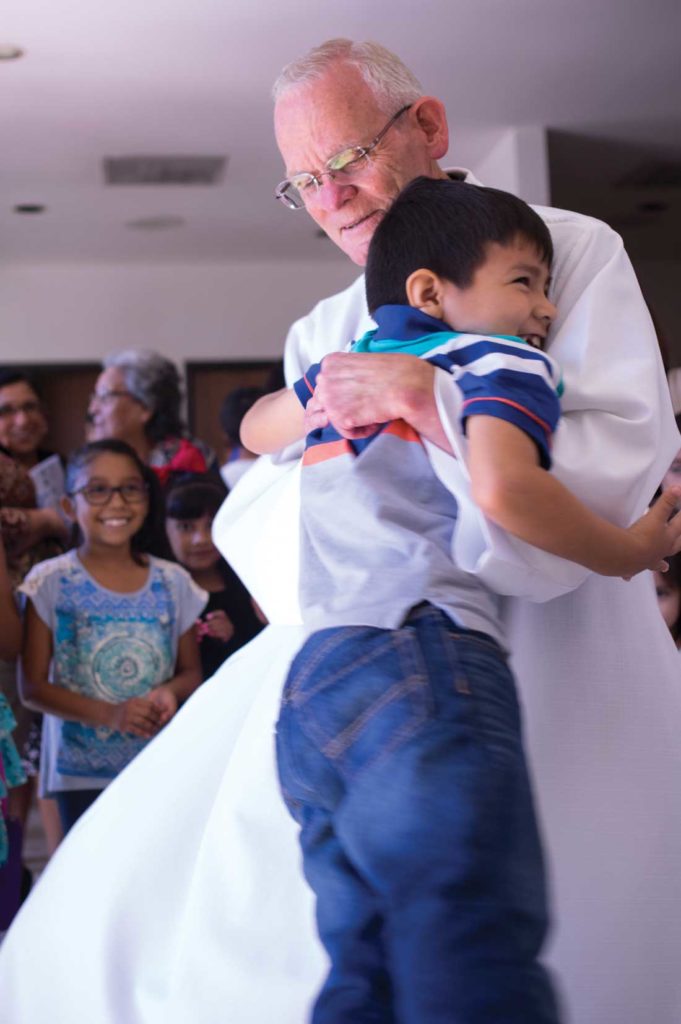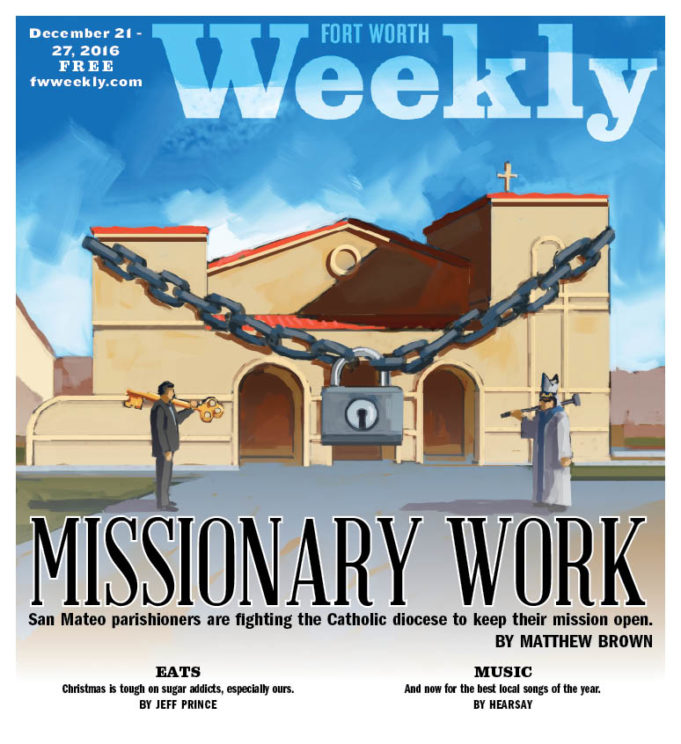The final Mass of the San Mateo Mission, on Sunday, Nov. 20, was an emotional event attended by hundreds of parishioners and supporters, packing the sanctuary. Father Bob Strittmatter looked weary in his chair near the altar, appearing slightly more hunched than usual with a handkerchief clutched in his palm. Throughout the service, some parishioners buried their faces in their hands or wiped tears from their eyes.
At the end, Strittmatter read a letter from the Diocese of Fort Worth, the governing body for local Catholic parishes.
In his soft voice, magnified over speakers, he read that any money raised in San Mateo’s name –– and there had already been thousands of dollars at this point –– could not be used in any legal battles with the diocese or other fights to keep the doors open. Strittmatter also read that parishioners could not take anything home from the sanctuary.
The statement was salt in the wound for people who thought they would at least be able to reclaim some items that had been donated by their families. Many of the mission’s trappings were provided by parishioners over the years, like the tapestry of St. Mary that hangs near the altar which was donated in the 1950s. Fear that the diocese might decide to bulldoze the property with little to no warning only added to the parishioners’ anxiety.
For the past 22 years, Strittmatter has been the mission’s priest. Although he still runs five miles three times a week, the 75-year-old will retire within the next few years. Instead of handing San Mateo off to a younger priest, he may be the ailing mission’s final shepherd.

The letter read at the final Mass in November was only the second official statement from the diocese about San Mateo. On September 11, Strittmatter read another letter, this one indicating that the mission would be closing permanently on November 20.
“Emotionally and psychologically, it is kind of like the death of a close friend,” said Strittmatter, who recalls vividly when the building was dedicated all those years ago.
When San Mateo was founded and built in 1941, the surrounding neighborhood was colloquially named El TP –– many of the residents worked at the Texas and Pacific railyards nearby. For many, San Mateo has been a place for spiritual development, but it also has been a home for community meetings and cultural celebrations.
For Yolanda Hendon, religion was as essential as school when she was growing up in El TP. She received her first sacrament and Holy Communion at the mission, and her grandparents were among San Mateo’s original members.
“It was instrumental in all our lives,” Hendon said. “It really helped shape our moral values. Everything was centered around the church.”
Hendon is leading a lawsuit against the diocese and its leader, Bishop Michael Olson, within the Catholic Church’s own justice system of canon law. Hendon is also working with civil lawyers to protect the church until the canon law case is settled.
Fred Flores, one of the congregation’s most vocal members in the defense of San Mateo, speaks passionately about the mission where he met his wife and how he learned the philosophies to which he attributes his 30 years of success as the owner of an insurance company.
“I was brought up in San Mateo, born and raised a block away from the church,” Flores said. “San Mateo set the foundation for my life.”
Even though hundreds have rallied behind the mission, Olson has not made any public comments and the diocese has released only two statements since September, including the letter announcing the closure.
Emerico Perez’s connection to the ill-fated mission is as close as anyone’s. His father played acoustic guitar in the choir and was active in San Mateo before his death; Perez’s 86-year-old mother still attends mass there. Perez has since followed in his father’s footsteps. He was an altar boy and a member of the choir and the men’s club, and now he has passed that along to his children.
The diocese, Perez believes, has been passively reducing the significance of the mission over the past several years while pressuring the congregation to move to St. Patrick Cathedral downtown –– San Mateo is considered a mission of the diocese’s flagship church, not a standalone entity. Some parishioners have announced their refusal to attend mass at St. Patrick’s.
“A lot of them say they don’t know what they’re going to do,” Perez said. “They are really concerned because they don’t want to go to any other church.”
Perez and the other San Mateo parishioners say that the manner in which the diocese has handled the situation has been less than open. They say that if the bishop had communicated with them and explained why he decided to close their mission, they would be more amenable.
“If they had put that San Mateo would possibly close if they didn’t accomplish certain things, I can guarantee they would have accomplished it,” Flores said. “For them to put us in this position is a slap to our faces, because it is not giving us the opportunity to help keep it open.”
The perceived callousness with which the diocese is allegedly treating the congregation has caused spiritual anguish among some parishioners –– both Perez and Flores have questioned their faith at times. Perez said that he is still a Catholic, but now he struggles with his faith in the institution.
“If it closes, I will have second thoughts of being a Catholic,” Flores said. “That’s how much it means to me. I never thought I would say those words, but I feel like I’m being let down by the people I look up to.”
*****
In the 1930s, dozens of working-class Latino families with children and elderly grandparents walked the three miles from El TP, at West Vickery Boulevard and Montgomery Street, to St. Patrick’s, on the edge of downtown, every weekend. Many were the families of poor Hispanic railroad workers; cars were a luxury they couldn’t afford.
St. Patrick’s was the closest place where residents of the barrio could attend Catholic mass before San Mateo was built. So every Sunday, regardless of whatever weather Texas offered, El TP folks trekked downtown to St. Patrick’s.

The diocese wouldn’t exist for nearly 30 more years, so two parishioners, Andrea Martinez and Betty Gonzales, made a plea to the leadership at St. Patrick to send a priest to El TP to perform Mass for the faithful community there. For a time, the Martinez house was where El TP families gathered every week for Holy Communion and the gospel.
As a mission under St. Patrick’s, San Mateo and its property were owned by St. Patrick’s. The priest had to be sent to San Mateo every week because missions do not have their own priests. Although the diocese maintains that the mission has never been self-sustaining, in part because it never had its own priest, Flores said that at some point in the mission’s history it became its own parish because it had a monsignor, an honorary title for a member of the clergy. Nuns from Mexico would visit yearly to teach the Catechism to the congregation as well, he said.
“That’s where we got our Catholic education,” Flores said.
San Mateo, he continued, was “actually very vibrant at the time.”
The mission continued to grow, and when the building fell into the path of construction of a bridge on Rosedale Street, the congregation took the opportunity to expand. Perez reminisces about how the congregation came together to help move San Mateo a short distance away in the 1970s.
“When they closed the original church down and bought the property across the street, there were a couple houses,” Perez said. “We all pitched in and knocked them down to make room for the church.”
That kind of community involvement is part of why Perez says the mission is so vital to the residents of El TP. For decades, San Mateo has hosted Spanish festivals and fundraisers, also known as jamaica [pronounced huh-my-cuh], to raise money for the mission and celebrate traditional culture from south of the border. Graduations, quinceaneras, and other milestones are all celebrated at the mission.
Due to more road construction, San Mateo was forced to move again, this time in 1998, to its current location on Lovell Avenue. The Martinez house had long since burned down in a string of suspected arsons that occurred in the 1980s, although it had already been abandoned due to the expansion of I-30. Like the original building, most of the neighborhood has been wiped away, and San Mateo remains as one of last vestiges of the barrio’s history.
Even though the neighborhood has practically disappeared, Spanish Mass can still draw several hundred parishioners, and families are forced to sit on pews in the lobby, watching through windows and listening over a garbled PA system.
“That church held the whole community together,” Perez said. “It means a lot to us.”
*****
At first, parishioners were confused by what Strittmatter was saying to them. The letter described how the diocese planned to lock San Mateo’s doors permanently more than 70 years after it began serving El TP. The announcement still shocks and dismays many parishioners, who had been told repeatedly that there were no plans to shutter the mission.
In the statement, the diocese attributed a “greatly diminished” attendance as one of the reasons for San Mateo’s closure. Perez and Flores said that any drop in attendance is attributable to St. Patrick’s attitude toward the congregation, an attitude that has alienated San Mateo’s parishioners.
Throughout San Mateo’s history, attention from the diocese has been seemingly reluctant at times. According to several members of the congregation, Olson has visited the mission only once since he was appointed bishop, at the beginning of 2014, when he visited every parish and mission within his sphere of influence.
Since Strittmatter read the first official statement to the congregation in early September, communication from not only the bishop but the entire diocese has been virtually nonexistent. The only other official communication was the second letter read by Strittmatter, at the end of the mission’s final service more than two months later.
When Olson was appointed bishop, he established a committee populated by members of the mission’s congregation, including Hendon and Perez, who claims it was promptly disbanded without any acknowledgment of their work. Meanwhile, people associated with St. Patrick’s and the diocese were given administrative power over activities and facilities at San Mateo, Perez and Hendon said.
“Everything has to be approved by certain people at St. Patrick’s,” Flores said. “Otherwise, it doesn’t get done. If St. Patrick’s says no, they mean no, and it’s a done deal.”
The motivation behind any increased involvement in administration by the diocese over the past four years has come into question by some members of San Mateo’s congregation. The first letter from the diocese states that the last three bishops have questioned whether San Mateo should continue to exist. But Perez said that in 2013, the diocese gave the green light for the construction of a new parish hall while throwing in a loan of about $900,000 to cover the cost of construction and land acquisition.
The new hall has classrooms for Confraternity of Christian Doctrine (CCD) classes plus a religious education program and an area for receptions and events that can be rented out. Since completion, however, the parish hall has been inaccessible to many parishioners, Perez said. The main building with the sanctuary, where mass is performed, is unlocked for mass and then locked again once services are finished. Even though the mission has been open for more than two decades, a proper parking lot has yet to be built, further frustrating people who attend mass there.
In an early October email conversation between a priest from St. Patrick’s and a San Mateo parishioner, the priest declares that the mission would not be made available for the fall jamaica. There was talk of the festival being held elsewhere, but it was the first time in decades that San Mateo would not host the cultural celebration. Flores and Perez believe St. Patrick’s rejected the jamaica organizers because money that is raised at the festival would have gone toward San Mateo rather than St. Patrick’s.
“I bet they would let us have it if we gave all the money to St. Patrick’s,” Flores said with a laugh.
On September 13, two days after the announcement of San Mateo’s closure, a meeting was scheduled by parishioners in the parish hall to discuss the issue, but when folks started arriving the doors were locked. Some parishioners believe Strittmatter was inside. (Strittmatter declined to comment.) With children and the elderly waiting outside the locked doors, Perez and scores of others were instead forced to have an impromptu meeting on the lawn, under the heat of the Texas sun.
Part of Hendon’s work on the civil suit is investigating whether the diocese could be guilty of fraud. At the center could be the new hall that many in the congregation have been unable to use, even though they have donated thousands of dollars to its construction. Perez said that the men’s club alone donated at least $50,000 toward the hall.
A financial report released by the diocese in June said that less than $80,000 of the $900,000 loan remains to be paid on the hall. Several parishioners believe that the diocese may have used the congregation to pay for the new hall to increase the value of the property before selling it.
“If the intent was to build that family center to sell it, that’s fraud,” Flores said. “If they had any plans whatsoever [to close San Mateo], [the hall] should have never been built with the people’s money.”
The belief among San Mateo parishioners is that St. Patrick’s is in the red.
This year, St. Patrick’s had a $174,630 budget deficit with a total of $2,685,922 in debt and unpaid bills, according to the same financial report. The Tarrant Appraisal District’s website states that San Mateo is appraised for property tax purposes at $1,350,649. TAD appraised the land at $447,575 and the buildings at $903,074.
Perez estimates that the market value of both buildings and the land could be significantly more, enough to wipe St. Patrick’s slate clean. The letter to San Mateo’s congregation doesn’t address the church’s debts, plans for the property, or how money from the sale of the mission would potentially be used.
“When the value of the property started going up, they started looking at us,” Perez said.
According to the same financial report, San Mateo operated during the same period of time with a $120 budget surplus after a total of $112,640 in revenue. Strittmatter’s salary isn’t included in San Mateo’s budget, but a San Mateo member offered the diocese $1,000 a week for three years on the premise that San Mateo would be established as a bona fide church and a younger priest would be sent to replace Strittmatter. The offer never received a response.
The major goal of Hendon’s work with civil lawyers is to prevent the diocese from selling or altering the property until the future of San Mateo is decided by the Vatican in canon law. That work proved critical when the diocese obtained a permit for the demolition of San Mateo on the Monday before the mission’s final Mass.
A spokesperson for the diocese, Pat Svacina, said in an email this week that an agreement has since been reached between San Mateo’s attorneys and the diocese: Until March 2017, the property will be left alone and that no legal action will be taken against the diocese.
Flores said he’s willing to work with the diocese “in good faith.”
That agreement buys time for a lawyer out of Ohio who specializes in canon law.Tasked by San Mateo members to pursue means within the Catholic hierarchy to keep the mission open, Philip Gray said that if the Vatican votes in San Mateo’s favor, the diocese would be on the line for any damages not only to the building but also to the parishioners who have records of donations.
Gray flew into Fort Worth the Friday before the mission’s final Mass to answer questions from members of the congregation. At the meeting, Gray said that canon law dictates that members of a church have a specified amount of time to appeal a closure and that the diocese is required to respond within 30 days. Gray said that an appeal with 564 signatures did not receive a response from Olson or the diocese within that time frame.
One area of contention between the congregation and the diocese is whether or not San Mateo is classified as a church or a mission. The latter is not considered an independent entity and does not own its own property. A mission does not pay any taxes to the diocese under canon law, unlike a church, which is required to do so. Perez said that San Mateo has been paying these taxes for several years.
Perez believes that over time St. Patrick’s and the diocese have been slowly dismantling the mission and that a larger plan has resulted: closing the mission. San Mateo no longer has any youth programs, which has decreased overall attendance, Perez said. But Perez and Flores stated that around 200 children were attending CCD classes at San Mateo before the diocese merged those programs with the classes at St. Patrick’s around a year ago.
“St Patrick’s set us up to fail,” Perez said.
*****
Dressed plainly, Perez strode beneath the Roman sun across the gray bricks toward the officers of the Swiss Guard. He had come to a Vatican checkpoint as hundreds of onlookers stood in risers to either side. A man dressed in a flamboyant blue, red, and yellow uniform raised his arm in a salute to the Fort Worth native. Perez had traveled to Rome for a vacation with his wife and had stopped to deliver letters to the pope with an appeal for San Mateo.
It is perhaps the grandest gesture in the fight for San Mateo. But it is not the only one. Aside from the hundreds of signatures on the appeal to Olson and the two lawsuits, there have been smaller acts of protest against the decision to close the mission.
Meetings and protests are organized via a Facebook group page with more than 400 likes called Save San Mateo Church. It posts updates on efforts to keep the doors from closing, and events have included candlelight vigils at the mission and silent protests at St. Patrick’s. At one protest downtown, some San Mateo parishioners believe they argued with Olson. Flores said that the bishop approached several women who were silently praying their rosaries and told them to leave, denying that they were with San Mateo.
“One of the gentlemen there jumped into a little shouting match with the bishop,” Flores said. “He told them that they were a part of San Mateo and that [Bishop Olson] had no business disrespecting the ladies the way he was doing.”
While some parishioners have been defiant toward the diocese, Flores said that notions of obedience are firmly rooted in the minds of lifelong Catholics. Flores said that the church, in a sense, conditions or brainwashes people into believing that they cannot dissent against the establishment or the people who run it.
“In the Hispanic community, [Hispanics] are obligated,” Perez said. “That’s the way we are raised. You respect the church. You do what they say.”
But Perez believes the church isn’t always right.
Flores feels that disobeying the church is a borderline sin in Hispanic culture. That makes rebelling against the diocese a tough sell for conflicted parishioners at San Mateo.
“You have to rethink your commitment,” Flores said. “Is this something that God would want?”
Olson is also the publisher of the magazine North Texas Catholic. In an article from the November issue, he writes about the balance of politics and religion in a Catholic’s life. Perhaps, while speaking on another subject, Olson himself best gives voice to what the dissenting parishioners are feeling toward their diocese.
“We must work actively and specifically in other ways to promote and to defend the good that the particular evil undermines,” Olson said. “Failure to do so is to sin seriously by omission.”
*****
With the final service over, Strittmatter left the sanctuary and stood in the foyer near the door as the congregation filtered past. Many parishioners embraced him as they walked by, some with tears in their eyes. As he always has, the aging priest picked up every child to twirl, a couple spins to the left and then to the right several more times, their legs swinging as they smiled over his shoulder.

Photo by Matthew Brown.
The mission’s priest won’t comment on the closure. Perez and Hendon believe there is a fear that the diocese might punish him if he does. But as he raised each child up, a thin smile crept across his face, and it became clear that he cares deeply for his flock. An October 22 Facebook post shows the elderly priest standing with members of San Mateo outside the building during a candlelight vigil, and the post said that he prayed with parishioners for the mission to stay open.
“Even the priest, I think he’s suffering quite a bit,” Flores said. “I think deep inside he definitely doesn’t want to see [San Mateo] closed either.”
Once the majority of the congregation departed, several members lingered behind, with Flores, Perez, and Hendon among them. One woman lay prostrate before the altar. Another sat in a pew near the altar and quietly cried.
A woman whose family has been attending San Mateo for decades walked in with a power drill to open a box underneath the tabernacle with the help of Perez. The tabernacle is the container kept in every Catholic Church that holds the Eucharist, the chalice for Communio n. Strittmatter protested while the woman explained that her father had left some sort of keepsakes for future parishioners in the box that she feared would be bulldozed with the building.
Inside the box, she found newspapers from the building’s dedication in a plastic bag that she entrusted to the priest for safekeeping. She also noted that a time capsule was buried beneath one of the building’s cornerstones and should be retrieved if the building was demolished.
Father Sojan George from St. Patrick’s arrived to help remove the Eucharist, which is much like removing the soul of a church or mission. As the priests left with the chalice, the woman who had been crying in her pew shouted at them that they had killed her church.
Gray believes that the mission has a strong case in canon law, but it can take upwards of a year for a decision to be made in the Vatican.
Perez said that he will fight until the end to save the mission, whether or not its doors have been locked temporarily or for the last time.
Strittmatter briefly spoke about San Mateo in September, and he hinted that hope was still alive.
“Something tells me it’s not over yet,” the aging priest said softly with a smile.













Wow what a great story. Not surprised that the church has some shady dealings.
Matthew Brown,
Please do an update on the San Mateo story.
The people there are fighting back.
God love them, but they are fighting back; it is a David vs. Goliath story
and San Mateo is still standing due to their efforts.
Who knows, but maybe the good guys will win this one.
God speed,
David Sheehan
Crowley (Fort Worth), Texas